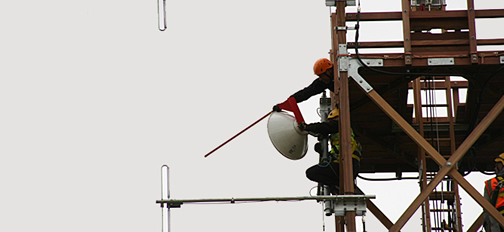Our new process helps save time on tower replacement
27 August 2014An innovative tool that eases the process of aligning microwave link dishes looks set to save NATS time and increase efficiency when replacing communication towers.
During the past six years, we have been undergoing a programme of replacing our oldest communications towers, which are between 40 and 60 years old and are approaching the end of their lives.
Alignment of the microwave link dishes is a critical activity within each tower replacement project – a vital step in the transition of communications services from the old to the new tower. Previously, this was done as one of the final operations of the transition but, as you would expect given the exposed location of such sites, the process is heavily dependent on the weather.

Alignment of the microwave link dishes is a critical element of tower replacements
A postponement due to poor weather could be extremely costly, not least because rescheduling the transition requires a minimum of three weeks, during which time the hired welfare facilities (canteen, toilets, etc.) and other equipment would all have to remain in place and labour would need to remain on call.
With this in mind the NATS Engineering Design team started to look for a more efficient method of dish alignment and consulted with us, the Survey and Drawing Services team. Co-incidentally we were already considering optical measurement as an alternative dish alignment method.
Colin Smithson, Senior Design Draughtsman, said: “We had an idea based on experience gained at another NATS site. There, we used laser theodolite technology to accurately check the existence of a clear ‘line of sight’ where other outside specialists were having difficulties. This led us to believe that perfect alignment could easily be attained for any ‘line of sight’ type application using our equipment and a 3D Computer Aided Design (CAD) reference model.”
This idea led to the design of a simple but innovative piece of kit: a sighting rod that bolts onto the back of the microwave link dish and sits perfectly parallel to the beam. The laser theodolite could then be used in conjunction with a live CAD model to work out the orientation of the dish in relation to the target tower.
In early June we took the equipment to the new tower site at Grantham and once assembled, it was bolted to the dish and a series of precise measurements using the laser theodolite were taken. From this data we accurately constructed the dish’s bearing on the CAD model with the whole process only taking just 3 hours to complete, with incredibly accurate results – a resounding success, exceeding all our expectations.
Following the success of the first alignment, we will now be using this technique across the tower replacement programme, as well as on other projects.
Comments
Please respect our commenting policy and guidelines when posting on this website.
